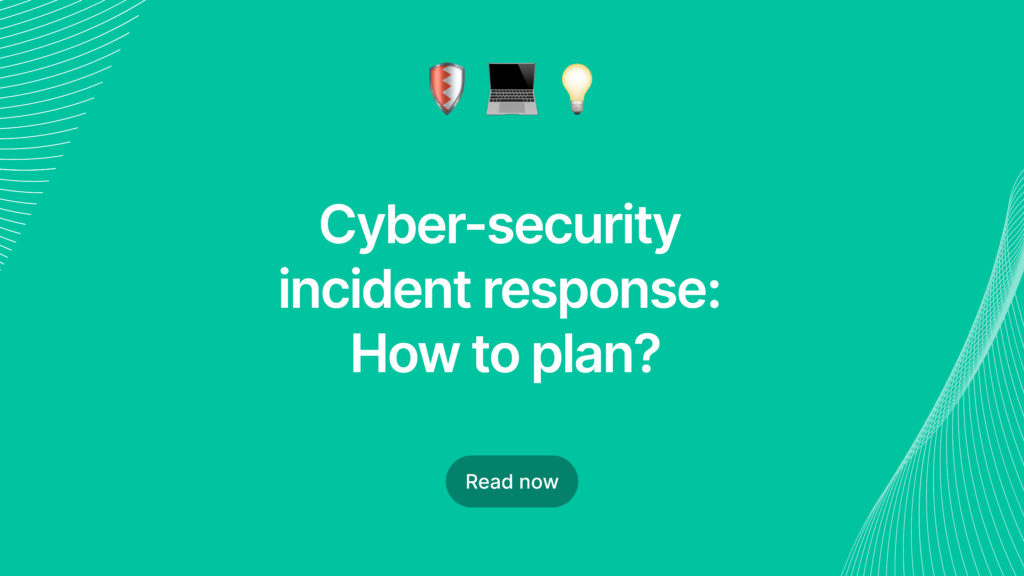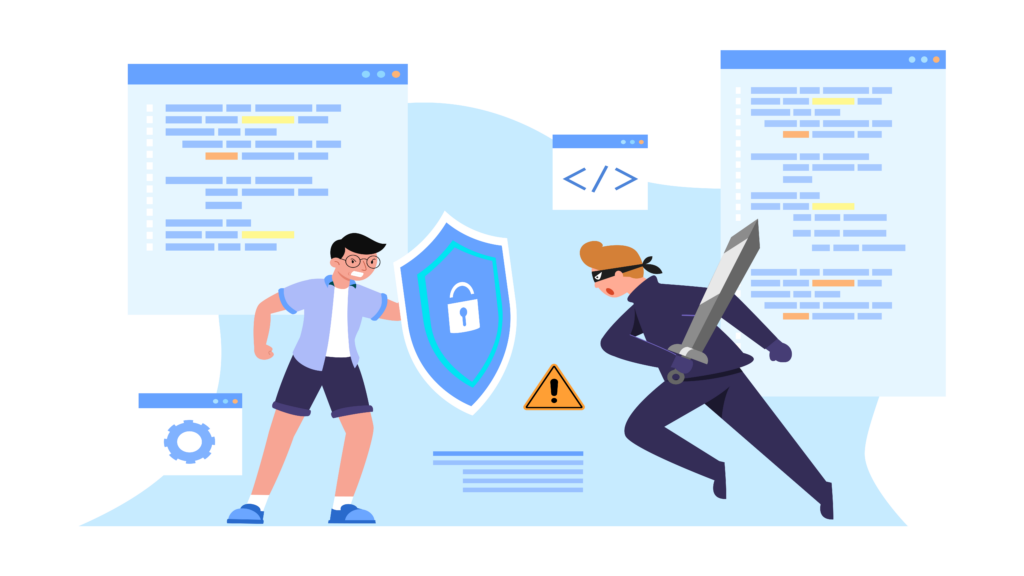
Cyber-attacks are becoming a big problem for businesses across the globe. One common mistake most small and medium-sized businesses make is they feel they are not under the radar of cyber-attacks. If you feel the same and don’t take cyber-security seriously then you have all the necessary elements to qualify for being the next target to the scammers.
So, being prepared for cyber-attacks at any time is one of the best ways to either keep them at bay or get away with minimum damage. This blog covers how you can create a cyber-security incident response plan and some of the most common phishing attacks around the globe.
Types of cyber-security incidents
Unauthorized attempts to key systems & data
When an individual or a group tries to get access to your system to get all the details and it is one of the most common forms of attack. Some of the common examples include hacking attempts, social engineering, and attacks with brute force.
Privilege escalation attack
In this type of attack the attacker gets access to the system through a limited privilege and then uses it to gain access to higher-level privileges. One can achieve this by exploiting vulnerabilities in the system or stealing credentials from the actual owner.
Insider threat
When a person currently employed or formerly associated with a company, whether as an employee, contractor, or insider, exploits their authorized access to the organization’s systems or data with malicious intentions. This may involve actions such as pilfering sensitive information or deliberately undermining the integrity of the systems.
Phishing attack
When someone sends an email or message that seems legit but is a trap, it’s called a phishing attack. The sender pretends to be from a trustworthy source, aiming to trick you into revealing sensitive info or downloading harmful software.
Malware attack
Occurs when an attacker uses malware, such as a virus or Trojan horse, to gain access to an organization’s systems or data or perform other malicious activities. Different types of malware can perform different activities. For example, ransomware can prevent access to data until a ransom has been paid.
Denial-of-service (DoS) Attack
When a system or network is flooded with traffic by an attacker, making it off-limits to regular users, it’s called a Denial-of-Service (DoS) Attack.
Man-in-the Middle (MitM) Attack
Imagine someone meddling in your conversation by intercepting and changing messages between two parties. That’s a Man-in-the-Middle (MitM) Attack, where the attacker can snatch sensitive info or spread malware.
Advanced Persistent threat (APT)
And then there’s the big league – an Advanced Persistent Threat (APT). It’s a fancy attack plan, super smart and focused on sneaking into a company’s systems for the long haul, either stealing secrets or sticking around for a while.

Cyber-security incident response plan: Six phases of incident response life cycle
The key steps involved during the process of cyber-security incident response plan are,
1: Preparing all the systems and procedures
2: Creating a detailed list of incidents
3: Containment of attackers & incident activity
4: Eradication of attackers & re-entry options
5: Recovery from incidents, including restoration of systems
6: Lessons learned and applying feedback during the next round of the preparation
Preparation
In the initial preparation stage, you evaluate current security measures and policies to gauge their effectiveness. This includes conducting a risk assessment to identify existing vulnerabilities and prioritize your assets. The gathered information guides the prioritization of responses for different incident types. If feasible, system reconfiguration is done to address vulnerabilities, emphasizing protection for high-priority assets.
During this phase, existing policies and procedures are fine-tuned, and new ones are crafted if needed. This includes developing a communication plan and defining roles and responsibilities for handling incidents. It’s all about refining and, if necessary, creating the playbook for responding to potential security issues.
Identification of threats
Utilizing tools and procedures established in the preparation stage, teams engage in detecting and pinpointing any suspicious activity. Once an incident is spotted, team members collaborate to determine the attack’s nature, its origin, and the attacker’s objectives.
In the identification process, it’s crucial to safeguard and store any collected evidence for thorough analysis later. Responders meticulously document every step taken and all evidence discovered, ensuring comprehensive details. This documentation becomes valuable for potential legal action if the attacker is identified.
After confirming an incident during this phase, communication plans are set into motion. These plans notify security members, stakeholders, authorities, legal counsel, and eventually users about the incident and the necessary steps to be taken.
Containment of attackers
Once an incident is spotted, the focus shifts to containment strategies aimed at swiftly minimizing damage. The objective is to reach this stage promptly.
Containment unfolds in two key phases
1. Immediate Isolation
In the short term, swift measures are taken to isolate immediate threats. Picture it as creating a digital barricade – isolating the specific area of your network where the attacker lurks or taking an infected server offline, redirecting traffic to a backup system.
2. Sustained Protection
Looking ahead, additional access controls are enforced to secure unaffected systems. Simultaneously, clean and updated versions of systems and resources are ready for the recovery phase, ensuring a more robust defense against future threats.
Elimination of threats
In the heat of the action and even after containment, the complete impact of an attack comes into focus. Once the teams have a clear picture of all the systems and resources affected, they start the process of kicking out attackers and wiping out malware from the systems. This phase keeps going until every trace of the attack is wiped clean. Sometimes, it means temporarily taking systems offline, replacing compromised assets with fresh, untainted versions as part of the recovery process. It’s like giving the digital invaders the boot and restoring the digital landscape to its safe and sound state.
Recovery and restoration
Now comes the phase where teams bring in fresh, updated systems to replace the ones affected. Ideally, we’d want to restore systems without losing any data, but that’s not always a given.
In cases where data loss occurs, teams figure out the timing of the last clean data copy and restore from there. The recovery phase takes some time, involving continuous monitoring of systems post-incident to ensure those sneaky attackers don’t stage a comeback.
Feedback and fine-tuning
After the dust settles, it’s time for the lessons learned session. Your team must reflect on the response steps—what worked smoothly, what didn’t, and tosses in ideas for future improvements. This phase is also the cleanup crew, making sure all the documentation is neatly tied up. It’s all about getting better and stronger for whatever digital challenges come in your way!

Benefits of cyber-security incident response plan
1. Structured defense strategy
A well-thought-out Incident Response Plan (IRP) helps your organization tackle cyber threats in an organized way. It reduces recovery time, protects crucial infrastructure, and manages cybersecurity risks effectively.
2. Building trust
Keeping an updated response plan boosts stakeholder confidence. This process establishes best practices for handling future threats and creates communication strategies, fostering trust among stakeholders.
3. Meeting regulations
Cybersecurity incident response planning helps your business comply with regulatory requirements, especially in industries like finance and healthcare. It ensures adherence to regulations such as GDPR, HIPAA, and PCI DSS, focusing on data protection.
4. Speedy recovery
A cybersecurity incident response plan is a practical tool to minimize operational downtime during an attack. Following a systematic approach in managing security incidents helps bring systems back online swiftly and efficiently.
Secure Your Future Today!
Don’t wait for a cyber storm to hit before securing your ship! Ensure your business is shipshape by getting expert help with a customized Cybersecurity Incident Response Plan. At Agira, we provide robust cybersecurity solutions for devices, applications, and networks.
Take the proactive step – get in touch now to fortify your business against cyber threats. Your security is our priority!






